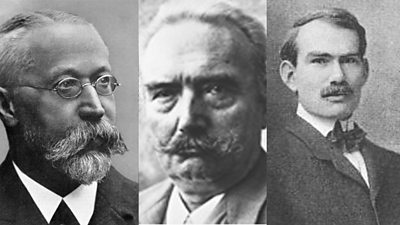Television had long been a dream of inventors; serious attempts to build a television system started over 100 years before even the name was invented. Up to the 1920s, television was still called by a variety of names including: Radiovision, Seeing by Wireless, Distant Electric Vision, Phototelegraphy, The Electric Telescope, Visual Listening, Telectroscopy, Hear-Seeing, Telephonoscope, Audiovision, Radio Movies, The Radio Kinema, Radioscope, Lustreer, Farscope, Optiphone, Mirascope.
By the time modern television became a reality, in the mid 1930s, there had already been over 50 serious proposals for television. The competition was truly international, with inventors and companies working in 11 different countries. Many of these pioneers had no success; a few however were able to produce silhouette pictures and were hailed as the 'inventors' of television within their own countries.
Thus, the French say both Belin and Barthelemy were the inventors of television; the Japanese believe it was Takayanagi; the Russians say Boris Rosing; the Germans either Nipkow or Karolus; the Hungarians von Mihaly; in the USA most people believe it was either Jenkins or Farnsworth; and in the UK we have the choice of Campbell-Swinton for the concept, or John Logie Baird for television's practical demonstration.
Although several pioneers had been working on the invention of television as far back as the 1850s, there were four key technologies that had to be developed before any form of television could become a possibility. These were:
- a device to change light into an electric current
- a device to change the electric current back into light
- a scanning device to break the image up into small elements
- an electronic amplifier to increase weak signals to a usable level
Once all of these inventions were in place, they would still need further development before a successful television system could be invented.

The first of the four key inventions happened in 1873 when a telegraph operator discovered that light affected the electrical resistance of selenium. It was soon realised that it was possible to change light into electricity using a selenium photocell.
The next key invention came in 1884 when Paul Nipkow in Germany invented a disc with a single spiral of holes in it as a method of mechanical scanning for television. Although he was never able to build a working system, the Nipkow disc was later used by several TV pioneers as the basis for their own television systems.
What was needed now was some device to turn an electric current back into light. A conventional light bulb was unsuitable because it could not vary its brightness fast enough to produce a TV image. The Neon lamp was developed by Georges Claude in France in 1902 and was used by many early television pioneers.
However, the most important breakthrough had happened earlier (in 1897) when Karl Braun in Germany invented the cathode-ray tube. The 'Braun tube', although unusable for television at the time, would become the most important television display device for the next century.
The last invention in the chain came in 1906 when Lee de Forest in the USA invented the Amplion (amplifying triode valve), making it possible to amplify the weak video signals created by selenium photocells. A working amplifier took him another six years to develop, and nearly ten years would pass before this amplifier was improved enough for television.
So by 1922 all the key elements were in place for the invention of television, and inventors around the world sensed that success was within reach. Many of them had well equipped laboratories and sufficient funds for staff and equipment. It is therefore surprising that success was snatched by a most unlikely figure.
